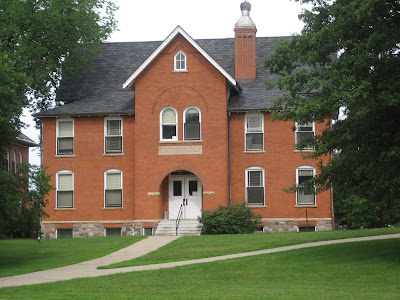
On West Circle Drive, on Michigan State's campus, stand 5 buildings, collectively known as "laboratory row." They represent good examples of late 19th century architecture, and still stand in an intact group. They are all registered on the State Register of Historic Sites.

Most of the information for this post comes from the book: MSU Campus: Buildings, Places, Spaces by Linda O. Stanford and C. Kurt Dewhurst.
Alfred J Cook Hall

Cook Hall is made of brick and Lake Superior Sandstone, and its most notable features are the round-headed windows above the front entrance, and the recessed entry doors.

It was the first agricultural lab on campus when it opened in 1909. It was known as the "entomology" building as the lettering above the entrance indicates. In 1948 with the completion of the Natural Science building, entomology was moved there. In 1969 this building got its new name, Cook Hall. It was named after Albert J. Cook (class of 1862), who was a professor of zoology and entomology, and also served as the first curator of the museum.

Alfred K. Chittenden Hall

Chittenden Hall was built in 1901. It features a sunburst brick entryway arch, with round-headed second story windows which reiterate the shape of the entryway. My favorite part is the frieze over the doorway with the word "Forestry" with the strokes and serifs of the letters being represented as tree trunks and limbs.

It was the first campus building designed for dairy operations. In 1913 when the dairy moved to a new building, the frieze was changed from stone carved "Dairy" to "Forestry." The Department of Forestry continued to use the building until 1966. In 1969, the building was given a new name to honor the achievements in forestry of Professor Alfred K Chittenden, who ran the forestry program from 1914-1930.
Old Botany

The Old Botany building has a Queen Anne style with lots of irregularities, with various windows, chimneys, and gables adding to the variety.
Professor Beal's first botany lab housed his botanical museum, but unfortunately burned down in 1890. This was the second botany lab, built in 1892. The corner stone inscription: "Botany A. D. 1992" is still very prominent. An addition was built in 1908.

Marshall Hall

Marshall Hall is stylistically eclectic. My favorite part is the cavernous arched entrance made from Michigan field stone, brick, and limestone.

In 1903 the building was known as Bacteriology. It was the first structure in US for research and teaching in this field. The building is named for Dr. Charles E. Marshall, who was head of the department of bacteriology and Hygiene from 1902-1912.
Eustace-Cole Hall

Eustace-Cole Hall is the 3rd oldest extant building on campus. It is known for its prominent shingled gable and stair tower. My favorite part is the conical tower, and emphatic arched entry.

It was built in 1888 by Liberty Hyde Bailey, as the first horticultural lab of its kind in the US. It was renamed in 1961 for Professor Henry Eustace, head of the depart
 Image via Wikipedia
Image via Wikipedia
Image of Liberty Hyde Bailey

![Reblog this post [with Zemanta]](http://img.zemanta.com/reblog_e.png?x-id=5f92e0e8-393b-4c69-a4ad-c877b43426e9)
Tom ..you MSU pictures are great. I like the way you take time to tell about each building and have the pictures to match. I hope you find time to do some more later!
ReplyDelete